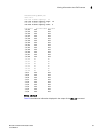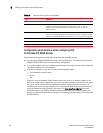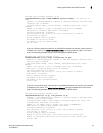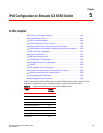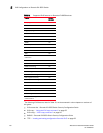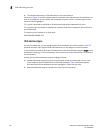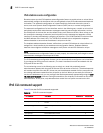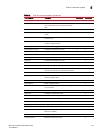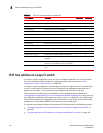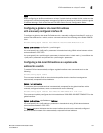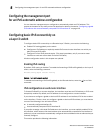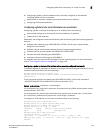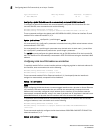
Brocade ICX 6650 Administration Guide 103
53-1002600-01
IPv6 addressing overview
5
.
A switch automatically configures a link-local unicast address for an interface by using the prefix of
FE80::/10 (1111 1110 10) and a 64-bit interface ID. The 128-bit IPv6 address is then subjected to
duplicate address detection to ensure that the address is unique on the link. If desired, you can
override this automatically configured address by explicitly configuring an address.
NOTE
Brocade ICX 6650 devices support RFC 2526, which requires that within each subnet, the highest
128 interface identifier values reserved for assignment as subnet anycast addresses. Thus, if you
assign individual IPv6 addresses within a subnet, the second highest IPv6 address in the subnet
does not work.
TABLE 22 IPv6 address types
Address
type
Description Address structure
Unicast An address for a single
interface. A packet sent to a
unicast address is delivered to
the interface identified by the
address.
Depends on the type of the unicast address:
• Aggregatable global address—An address equivalent to a global
or public IPv4 address. The address structure is as follows: a
fixed prefix of 2000::/3 (001), a 45-bit global routing prefix, a
16-bit subnet ID, and a 64-bit interface ID.
• Site-local address—An address used within a site or intranet.
(This address is similar to a private IPv4 address.) A site
consists of multiple network links. The address structure is as
follows: a fixed prefix of FEC0::/10 (1111 1110 11), a 16-bit
subnet ID, and a 64-bit interface ID.
• Link-local address—An address used between directly
connected nodes on a single network link. The address
structure is as follows: a fixed prefix of FE80::/10 (1111 1110
10) and a 64-bit interface ID.
• IPv4-compatible address—An address used in IPv6 transition
mechanisms that tunnel IPv6 packets dynamically over IPv4
infrastructures. The address embeds an IPv4 address in the
low-order 32 bits and the high-order 96 bits are zeros. The
address structure is as follows: 0:0:0:0:0:0:A.B.C.D.
• Loopback address—An address (0:0:0:0:0:0:0:1 or ::1) that a
switch can use to send an IPv6 packet to itself. You cannot
assign a loopback address to a physical interface.
• Unspecified address—An address (0:0:0:0:0:0:0:0 or ::) that a
node can use until you configure an IPv6 address for it.
Multicast An address for a set of
interfaces belonging to
different nodes. Sending a
packet to a multicast address
results in the delivery of the
packet to all interfaces in the
set.
A multicast address has a fixed prefix of FF00::/8 (1111 1111). The
next 4 bits define the address as a permanent or temporary
address. The next 4 bits define the scope of the address (node, link,
site, organization, global).
Anycast An address for a set of
interfaces belonging to
different nodes. Sending a
packet to an anycast address
results in the delivery of the
packet to the closest interface
identified by the address.
An anycast address looks similar to a unicast address, because it is
allocated from the unicast address space. If you assign a unicast
address to multiple interfaces, it is an anycast address. An interface
assigned an anycast address must be configured to recognize the
address as an anycast address.
An anycast address can be assigned to a switch only.
An anycast address must not be used as the source address of an
IPv6 packet.



